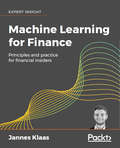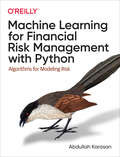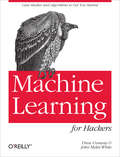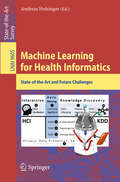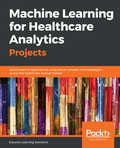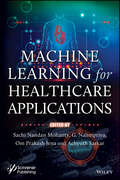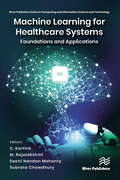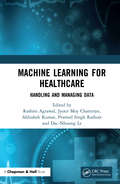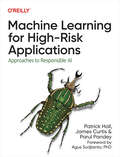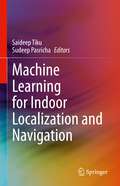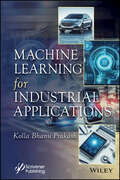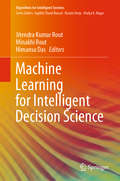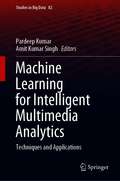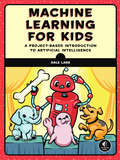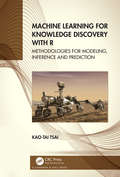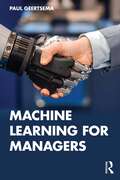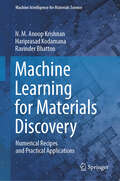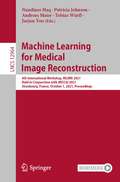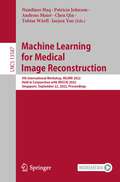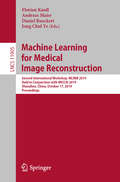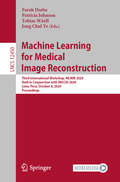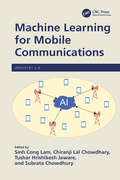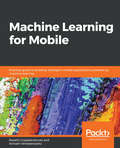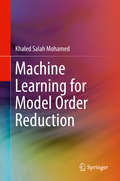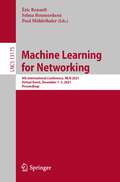- Table View
- List View
Machine Learning for Finance: The practical guide to using data-driven algorithms in banking, insurance, and investments
by Jannes KlaasPlan and build useful machine learning systems for financial services, with full working Python codeKey FeaturesBuild machine learning systems that will be useful across the financial services industryDiscover how machine learning can solve finance industry challengesGain the machine learning insights and skills fintech companies value mostBook DescriptionMachine learning skills are essential for anybody working in financial data analysis. Machine Learning for Finance shows you how to build machine learning models for use in financial services organizations. It shows you how to work with all the key machine learning models, from simple regression to advanced neural networks.You will see how to use machine learning to automate manual tasks, identify and address systemic bias, and find new insights and patterns hidden in available data. Machine Learning for Finance encourages and equips you to find new ways to use data to serve an organization’s business goals.Broad in scope yet deeply practical in approach, Machine Learning for Finance will help you to apply machine learning in all parts of a financial organization’s infrastructure. If you work or plan to work in fintech, and want to gain one of the most valuable skills in the sector today, this book is for you.What you will learnPractical machine learning for the finance sectorBuild machine learning systems that support the goals of financial organizationsThink creatively about problems and how machine learning can solve themIdentify and reduce sources of bias from machine learning modelsApply machine learning to structured data, natural language, photographs, and written text related to financeUse machine learning to detect fraud, forecast financial trends, analyze customer sentiments, and moreImplement heuristic baselines, time series, generative models, and reinforcement learning in Python, scikit-learn, Keras, and TensorFlowWho this book is forMachine Learning for Finance is for financial professionals who want to develop and apply machine learning skills, and for students entering the field. You should be comfortable with Python and the basic data science stack, such as NumPy, pandas, and Matplotlib, to get the most out of this book.
Machine Learning for Financial Risk Management with Python: Algorithms for Modeling Risk
by Abdullah KarasanFinancial risk management is quickly evolving with the help of artificial intelligence. With this practical book, developers, programmers, engineers, financial analysts, risk analysts, and quantitative and algorithmic analysts will examine Python-based machine learning and deep learning models for assessing financial risk. Building hands-on AI-based financial modeling skills, you'll learn how to replace traditional financial risk models with ML models.Author Abdullah Karasan helps you explore the theory behind financial risk modeling before diving into practical ways of employing ML models in modeling financial risk using Python. With this book, you will:Review classical time series applications and compare them with deep learning modelsExplore volatility modeling to measure degrees of risk, using support vector regression, neural networks, and deep learningImprove market risk models (VaR and ES) using ML techniques and including liquidity dimensionDevelop a credit risk analysis using clustering and Bayesian approachesCapture different aspects of liquidity risk with a Gaussian mixture model and Copula modelUse machine learning models for fraud detectionPredict stock price crash and identify its determinants using machine learning models
Machine Learning for Hackers: Case Studies and Algorithms to Get You Started
by John Myles White Drew ConwayIf you’re an experienced programmer interested in crunching data, this book will get you started with machine learning—a toolkit of algorithms that enables computers to train themselves to automate useful tasks. Authors Drew Conway and John Myles White help you understand machine learning and statistics tools through a series of hands-on case studies, instead of a traditional math-heavy presentation.Each chapter focuses on a specific problem in machine learning, such as classification, prediction, optimization, and recommendation. Using the R programming language, you’ll learn how to analyze sample datasets and write simple machine learning algorithms. Machine Learning for Hackers is ideal for programmers from any background, including business, government, and academic research.Develop a naïve Bayesian classifier to determine if an email is spam, based only on its textUse linear regression to predict the number of page views for the top 1,000 websitesLearn optimization techniques by attempting to break a simple letter cipherCompare and contrast U.S. Senators statistically, based on their voting recordsBuild a “whom to follow” recommendation system from Twitter data
Machine Learning for Health Informatics
by Andreas HolzingerMachine learning (ML) is the fastest growing field in computer science, and Health Informatics (HI) is amongst the greatest application challenges, providing future benefits in improved medical diagnoses, disease analyses, and pharmaceutical development. However, successful ML for HI needs a concerted effort, fostering integrative research between experts ranging from diverse disciplines from data science to visualization. Tackling complex challenges needs both disciplinary excellence and cross-disciplinary networking without any boundaries. Following the HCI-KDD approach, in combining the best of two worlds, it is aimed to support human intelligence with machine intelligence. This state-of-the-art survey is an output of the international HCI-KDD expert network and features 22 carefully selected and peer-reviewed chapters on hot topics in machine learning for health informatics; they discuss open problems and future challenges in order to stimulate further research and international progress in this field.
Machine Learning for Healthcare Analytics Projects: Build smart AI applications using neural network methodologies across the healthcare vertical market
by Eduonix Learning SolutionsCreate real-world machine learning solutions using NumPy, pandas, matplotlib, and scikit-learnKey FeaturesDevelop a range of healthcare analytics projects using real-world datasetsImplement key machine learning algorithms using a range of libraries from the Python ecosystemAccomplish intermediate-to-complex tasks by building smart AI applications using neural network methodologiesBook DescriptionMachine Learning (ML) has changed the way organizations and individuals use data to improve the efficiency of a system. ML algorithms allow strategists to deal with a variety of structured, unstructured, and semi-structured data. Machine Learning for Healthcare Analytics Projects is packed with new approaches and methodologies for creating powerful solutions for healthcare analytics.This book will teach you how to implement key machine learning algorithms and walk you through their use cases by employing a range of libraries from the Python ecosystem. You will build five end-to-end projects to evaluate the efficiency of Artificial Intelligence (AI) applications for carrying out simple-to-complex healthcare analytics tasks. With each project, you will gain new insights, which will then help you handle healthcare data efficiently. As you make your way through the book, you will use ML to detect cancer in a set of patients using support vector machines (SVMs) and k-Nearest neighbors (KNN) models. In the final chapters, you will create a deep neural network in Keras to predict the onset of diabetes in a huge dataset of patients. You will also learn how to predict heart diseases using neural networks.By the end of this book, you will have learned how to address long-standing challenges, provide specialized solutions for how to deal with them, and carry out a range of cognitive tasks in the healthcare domain.What you will learnExplore super imaging and natural language processing (NLP) to classify DNA sequencingDetect cancer based on the cell information provided to the SVMApply supervised learning techniques to diagnose autism spectrum disorder (ASD)Implement a deep learning grid and deep neural networks for detecting diabetesAnalyze data from blood pressure, heart rate, and cholesterol level tests using neural networksUse ML algorithms to detect autistic disordersWho this book is forMachine Learning for Healthcare Analytics Projects is for data scientists, machine learning engineers, and healthcare professionals who want to implement machine learning algorithms to build smart AI applications. Basic knowledge of Python or any programming language is expected to get the most from this book.
Machine Learning for Healthcare Applications
by Sachi Nandan Mohanty G. Nalinipriya Om Prakash Jena Achyuth SarkarWhen considering the idea of using machine learning in healthcare, it is a Herculean task to present the entire gamut of information in the field of intelligent systems. It is, therefore the objective of this book to keep the presentation narrow and intensive. This approach is distinct from others in that it presents detailed computer simulations for all models presented with explanations of the program code. It includes unique and distinctive chapters on disease diagnosis, telemedicine, medical imaging, smart health monitoring, social media healthcare, and machine learning for COVID-19. These chapters help develop a clear understanding of the working of an algorithm while strengthening logical thinking. In this environment, answering a single question may require accessing several data sources and calling on sophisticated analysis tools. While data integration is a dynamic research area in the database community, the specific needs of research have led to the development of numerous middleware systems that provide seamless data access in a result-driven environment. Since this book is intended to be useful to a wide audience, students, researchers and scientists from both academia and industry may all benefit from this material. It contains a comprehensive description of issues for healthcare data management and an overview of existing systems, making it appropriate for introductory and instructional purposes. Prerequisites are minimal; the readers are expected to have basic knowledge of machine learning. This book is divided into 22 real-time innovative chapters which provide a variety of application examples in different domains. These chapters illustrate why traditional approaches often fail to meet customers’ needs. The presented approaches provide a comprehensive overview of current technology. Each of these chapters, which are written by the main inventors of the presented systems, specifies requirements and provides a description of both the chosen approach and its implementation. Because of the self-contained nature of these chapters, they may be read in any order. Each of the chapters use various technical terms which involve expertise in machine learning and computer science.
Machine Learning for Healthcare Systems: Foundations and Applications (River Publishers Series in Computing and Information Science and Technology)
by Sachi Nandan Mohanty M. Rajalakshmi Subrata Chowdhury C. KarthikThe introduction of digital technology in the healthcare industry is marked by ongoing difficulties with implementation and use. Slow progress has been made in unifying different healthcare systems, and much of the world still lacks a fully integrated healthcare system. The intrinsic complexity and development of human biology, as well as the differences across patients, have repeatedly demonstrated the significance of the human element in the diagnosis and treatment of illnesses. But as digital technology develops, healthcare providers will undoubtedly need to use it more and more to give patients the best treatment possible. The extensive use of machine learning in numerous industries, including healthcare, has been made possible by advancements in data technologies, including storage capacity, processing capability, and data transit speeds. The need for a personalized medicine or "precision medicine" approach to healthcare has been highlighted by current trends in medicine due to the complexity of providing effective healthcare to each individual. Personalized medicine aims to identify, forecast, and analyze diagnostic decisions using vast volumes of healthcare data so that doctors may then apply them to each unique patient. These data may include, but are not limited to, information on a person’s genes or family history, medical imaging data, drug combinations, patient health outcomes at the community level, and natural language processing of pre-existing medical documentation. This book provides various insights into machine learning techniques in healthcare system data and its analysis. Recent technological advancements in the healthcare system represent cutting-edge innovations and global research successes in performance modelling, analysis, and applications.
Machine Learning for Healthcare: Handling and Managing Data
by Rashmi Agrawal, Jyotir Moy Chatterjee, Abhishek Kumar, Pramod Singh Rathore and Dac-Nhuong LeMachine Learning for Healthcare: Handling and Managing Data provides in-depth information about handling and managing healthcare data through machine learning methods. This book expresses the long-standing challenges in healthcare informatics and provides rational explanations of how to deal with them. Machine Learning for Healthcare: Handling and Managing Data provides techniques on how to apply machine learning within your organization and evaluate the efficacy, suitability, and efficiency of machine learning applications. These are illustrated in a case study which examines how chronic disease is being redefined through patient-led data learning and the Internet of Things. This text offers a guided tour of machine learning algorithms, architecture design, and applications of learning in healthcare. Readers will discover the ethical implications of machine learning in healthcare and the future of machine learning in population and patient health optimization. This book can also help assist in the creation of a machine learning model, performance evaluation, and the operationalization of its outcomes within organizations. It may appeal to computer science/information technology professionals and researchers working in the area of machine learning, and is especially applicable to the healthcare sector. The features of this book include: A unique and complete focus on applications of machine learning in the healthcare sector. An examination of how data analysis can be done using healthcare data and bioinformatics. An investigation of how healthcare companies can leverage the tapestry of big data to discover new business values. An exploration of the concepts of machine learning, along with recent research developments in healthcare sectors.
Machine Learning for High-Risk Applications: Approaches to Responsible AI
by Patrick Hall James Curtis Parul PandeyThe past decade has witnessed the broad adoption of artificial intelligence and machine learning (AI/ML) technologies. However, a lack of oversight in their widespread implementation has resulted in some incidents and harmful outcomes that could have been avoided with proper risk management. Before we can realize AI/ML's true benefit, practitioners must understand how to mitigate its risks. This book describes approaches to responsible AI—a holistic framework for improving AI/ML technology, business processes, and cultural competencies that builds on best practices in risk management, cybersecurity, data privacy, and applied social science. Authors Patrick Hall, James Curtis, and Parul Pandey created this guide for data scientists who want to improve real-world AI/ML system outcomes for organizations, consumers, and the public. Learn technical approaches for responsible AI across explainability, model validation and debugging, bias management, data privacy, and ML securityLearn how to create a successful and impactful AI risk management practiceGet a basic guide to existing standards, laws, and assessments for adopting AI technologies, including the new NIST AI Risk Management FrameworkEngage with interactive resources on GitHub and Colab
Machine Learning for Indoor Localization and Navigation
by Sudeep Pasricha Saideep TikuWhile GPS is the de-facto solution for outdoor positioning with a clear sky view, there is no prevailing technology for GPS-deprived areas, including dense city centers, urban canyons, buildings and other covered structures, and subterranean facilities such as underground mines, where GPS signals are severely attenuated or totally blocked. As an alternative to GPS for the outdoors, indoor localization using machine learning is an emerging embedded and Internet of Things (IoT) application domain that is poised to reinvent the way we navigate in various indoor environments. This book discusses advances in the applications of machine learning that enable the localization and navigation of humans, robots, and vehicles in GPS-deficient environments. The book explores key challenges in the domain, such as mobile device resource limitations, device heterogeneity, environmental uncertainties, wireless signal variations, and security vulnerabilities. Countering these challenges can improve the accuracy, reliability, predictability, and energy-efficiency of indoor localization and navigation. The book identifies severalnovel energy-efficient, real-time, and robust indoor localization techniques that utilize emerging deep machine learning and statistical techniques to address the challenges for indoor localization and navigation. In particular, the book:Provides comprehensive coverage of the application of machine learning to the domain of indoor localization;Presents techniques to adapt and optimize machine learning models for fast, energy-efficient indoor localization;Covers design and deployment of indoor localization frameworks on mobile, IoT, and embedded devices in real conditions.
Machine Learning for Industrial Applications
by Kolla Bhanu PrakashThe main goal of the book is to provide a comprehensive and accessible guide that empowers readers to understand, apply, and leverage machine learning algorithms and techniques effectively in real-world scenarios. Welcome to the exciting world of machine learning! In recent years, machine learning has rapidly transformed from a niche field within computer science to a fundamental technology shaping various aspects of our lives. Whether you realize it or not, machine learning algorithms are at work behind the scenes, powering recommendation systems, autonomous vehicles, virtual assistants, medical diagnostics, and much more. This book is designed to serve as your comprehensive guide to understanding the principles, algorithms, and applications of machine learning. Whether a student diving into this field for the first time, a seasoned professional looking to broaden your skillset, or an enthusiast eager to explore cutting-edge advancements, this book has something for you. The primary goal of Machine Learning for Industrial Applications is to demystify machine learning and make it accessible to a wide audience. It provides a solid foundation in the fundamental concepts of machine learning, covering both the theoretical underpinnings and practical applications. Whether you’re interested in supervised learning, unsupervised learning, reinforcement learning, or innovative techniques like deep learning, you’ll find comprehensive coverage here. Throughout the book, a hands-on approach is emphasized. As the best way to learn machine learning is by doing, the book includes numerous examples, exercises, and real-world case studies to reinforce your understanding and practical skills. Audience The book will enjoy a wide readership as it will appeal to all researchers, students, and technology enthusiasts wanting a hands-on guide to the new advances in machine learning.
Machine Learning for Intelligent Decision Science (Algorithms for Intelligent Systems)
by Himansu Das Minakhi Rout Jitendra Kumar RoutThe book discusses machine learning-based decision-making models, and presents intelligent, hybrid and adaptive methods and tools for solving complex learning and decision-making problems under conditions of uncertainty. Featuring contributions from data scientists, practitioners and educators, the book covers a range of topics relating to intelligent systems for decision science, and examines recent innovations, trends, and practical challenges in the field. The book is a valuable resource for academics, students, researchers and professionals wanting to gain insights into decision-making.
Machine Learning for Intelligent Multimedia Analytics: Techniques and Applications (Studies in Big Data #82)
by Amit Kumar Singh Pardeep KumarThis book presents applications of machine learning techniques in processing multimedia large-scale data. Multimedia such as text, image, audio, video, and graphics stands as one of the most demanding and exciting aspects of the information era. The book discusses new challenges faced by researchers in dealing with these large-scale data and also presents innovative solutions to address several potential research problems, e.g., enabling comprehensive visual classification to fill the semantic gap by exploring large-scale data, offering a promising frontier for detailed multimedia understanding, as well as extract patterns and making effective decisions by analyzing the large collection of data.
Machine Learning for Kids: A Project-Based Introduction to Artificial Intelligence
by Dale LaneA hands-on, application-based introduction to machine learning and artificial intelligence (AI) that guides young readers through creating compelling AI-powered games and applications using the Scratch programming language.Machine learning (also known as ML) is one of the building blocks of AI, or artificial intelligence. AI is based on the idea that computers can learn on their own, with your help. Machine Learning for Kids will introduce you to machine learning, painlessly. With this book and its free, Scratch-based, award-winning companion website, you'll see how easy it is to add machine learning to your own projects. You don't even need to know how to code! As you work through the book you'll discover how machine learning systems can be taught to recognize text, images, numbers, and sounds, and how to train your models to improve their accuracy. You'll turn your models into fun computer games and apps, and see what happens when they get confused by bad data. You'll build 13 projects step-by-step from the ground up, including: • Rock, Paper, Scissors game that recognizes your hand shapes • An app that recommends movies based on other movies that you like • A computer character that reacts to insults and compliments • An interactive virtual assistant (like Siri or Alexa) that obeys commands • An AI version of Pac-Man, with a smart character that knows how to avoid ghosts NOTE: This book includes a Scratch tutorial for beginners, and step-by-step instructions for every project.Ages 12+
Machine Learning for Knowledge Discovery with R: Methodologies for Modeling, Inference and Prediction
by Kao-Tai TsaiMachine Learning for Knowledge Discovery with R contains methodologies and examples for statistical modelling, inference, and prediction of data analysis. It includes many recent supervised and unsupervised machine learning methodologies such as recursive partitioning modelling, regularized regression, support vector machine, neural network, clustering, and causal-effect inference. Additionally, it emphasizes statistical thinking of data analysis, use of statistical graphs for data structure exploration, and result presentations. The book includes many real-world data examples from life-science, finance, etc. to illustrate the applications of the methods described therein. Key Features: Contains statistical theory for the most recent supervised and unsupervised machine learning methodologies. Emphasizes broad statistical thinking, judgment, graphical methods, and collaboration with subject-matter-experts in analysis, interpretation, and presentations. Written by statistical data analysis practitioner for practitioners. The book is suitable for upper-level-undergraduate or graduate-level data analysis course. It also serves as a useful desk-reference for data analysts in scientific research or industrial applications.
Machine Learning for Managers
by Paul GeertsemaMachine learning can help managers make better predictions, automate complex tasks and improve business operations. Managers who are familiar with machine learning are better placed to navigate the increasingly digital world we live in. There is a view that machine learning is a highly technical subject that can only be understood by specialists. However, many of the ideas that underpin machine learning are straightforward and accessible to anyone with a bit of curiosity. This book is for managers who want to understand what machine learning is about, but who lack a technical background in computer science, statistics or math. The book describes in plain language what machine learning is and how it works. In addition, it explains how to manage machine learning projects within an organization. This book should appeal to anyone that wants to learn more about using machine learning to drive value in real-world organizations.
Machine Learning for Materials Discovery: Numerical Recipes and Practical Applications (Machine Intelligence for Materials Science)
by Hariprasad Kodamana Ravinder Bhattoo N. M. KrishnanFocusing on the fundamentals of machine learning, this book covers broad areas of data-driven modeling, ranging from simple regression to advanced machine learning and optimization methods for applications in materials modeling and discovery. The book explains complex mathematical concepts in a lucid manner to ensure that readers from different materials domains are able to use these techniques successfully. A unique feature of this book is its hands-on aspect—each method presented herein is accompanied by a code that implements the method in open-source platforms such as Python. This book is thus aimed at graduate students, researchers, and engineers to enable the use of data-driven methods for understanding and accelerating the discovery of novel materials.
Machine Learning for Medical Image Reconstruction: 4th International Workshop, MLMIR 2021, Held in Conjunction with MICCAI 2021, Strasbourg, France, October 1, 2021, Proceedings (Lecture Notes in Computer Science #12964)
by Patricia Johnson Andreas Maier Tobias Würfl Nandinee Haq Jaejun YooThis book constitutes the refereed proceedings of the 4th International Workshop on Machine Learning for Medical Reconstruction, MLMIR 2021, held in conjunction with MICCAI 2021, in October 2021. The workshop was planned to take place in Strasbourg, France, but was held virtually due to the COVID-19 pandemic. The 13 papers presented were carefully reviewed and selected from 20 submissions. The papers are organized in the following topical sections: deep learning for magnetic resonance imaging and deep learning for general image reconstruction.
Machine Learning for Medical Image Reconstruction: 5th International Workshop, MLMIR 2022, Held in Conjunction with MICCAI 2022, Singapore, September 22, 2022, Proceedings (Lecture Notes in Computer Science #13587)
by Patricia Johnson Andreas Maier Tobias Würfl Nandinee Haq Jaejun Yoo Chen QinThis book constitutes the refereed proceedings of the 5th International Workshop on Machine Learning for Medical Reconstruction, MLMIR 2022, held in conjunction with MICCAI 2022, in September 2022, held in Singapore.The 15 papers presented were carefully reviewed and selected from 19 submissions. The papers are organized in the following topical sections: deep learning for magnetic resonance imaging and deep learning for general image reconstruction.
Machine Learning for Medical Image Reconstruction: Second International Workshop, MLMIR 2019, Held in Conjunction with MICCAI 2019, Shenzhen, China, October 17, 2019, Proceedings (Lecture Notes in Computer Science #11905)
by Daniel Rueckert Andreas Maier Florian Knoll Jong Chul YeThis book constitutes the refereed proceedings of the Second International Workshop on Machine Learning for Medical Reconstruction, MLMIR 2019, held in conjunction with MICCAI 2019, in Shenzhen, China, in October 2019. The 24 full papers presented were carefully reviewed and selected from 32 submissions. The papers are organized in the following topical sections: deep learning for magnetic resonance imaging; deep learning for computed tomography; and deep learning for general image reconstruction.
Machine Learning for Medical Image Reconstruction: Third International Workshop, MLMIR 2020, Held in Conjunction with MICCAI 2020, Lima, Peru, October 8, 2020, Proceedings (Lecture Notes in Computer Science #12450)
by Patricia Johnson Jong Chul Ye Farah Deeba Tobias WürflThis book constitutes the refereed proceedings of the Third International Workshop on Machine Learning for Medical Reconstruction, MLMIR 2020, held in conjunction with MICCAI 2020, in Lima, Peru, in October 2020. The workshop was held virtually. The 15 papers presented were carefully reviewed and selected from 18 submissions. The papers are organized in the following topical sections: deep learning for magnetic resonance imaging and deep learning for general image reconstruction.
Machine Learning for Mobile Communications (Industry 5.0)
by Chiranji Lal Chowdhary Subrata Chowdhury Sinh Cong Lam Tushar Hrishikesh JawareMachine Learning for Mobile Communications will take readers on a journey from basic to advanced knowledge about mobile communications and machine learning. For learners at the basic level, this book volume discusses a wide range of mobile communications topics from the system level, such as system design and optimization, to the user level, such as power control and resource allocation. The authors also review state-of-the-art machine learning, one of the biggest emerging trends in both academia and industry. For learners at the advanced level, this book discusses solutions for long-term problems with future mobile communications such as resource allocation, security, power control, and spectral efficiency. The book brings together some of the top mobile communications and machine learning experts throughout the world, who contributed their knowledge and experience regarding system design and optimization.This book: Discusses the 5G new radio system design and architecture as specified in 3GPP documents Highlights the challenges including security and privacy, energy, and spectrum efficiency from the perspective of 5G new radio systems Identifies both theoretical and practical problems that can occur in mobile communication systems Covers machine learning techniques such as autoencoder and Q-learning in a comprehensive manner Explores how to apply machine learning techniques to mobile systems to solve modern problems This book is for senior undergraduate and graduate students and academic researchers in the fields of electrical engineering, electronics and communication engineering, and computer engineering.
Machine Learning for Mobile: Practical guide to building intelligent mobile applications powered by machine learning
by Revathi Gopalakrishnan Avinash VenkateswarluLeverage the power of machine learning on mobiles and build intelligent mobile applications with ease Key Features Build smart mobile applications for Android and iOS devices Use popular machine learning toolkits such as Core ML and TensorFlow Lite Explore cloud services for machine learning that can be used in mobile apps Book Description Machine learning presents an entirely unique opportunity in software development. It allows smartphones to produce an enormous amount of useful data that can be mined, analyzed, and used to make predictions. This book will help you master machine learning for mobile devices with easy-to-follow, practical examples. You will begin with an introduction to machine learning on mobiles and grasp the fundamentals so you become well-acquainted with the subject. You will master supervised and unsupervised learning algorithms, and then learn how to build a machine learning model using mobile-based libraries such as Core ML, TensorFlow Lite, ML Kit, and Fritz on Android and iOS platforms. In doing so, you will also tackle some common and not-so-common machine learning problems with regard to Computer Vision and other real-world domains. By the end of this book, you will have explored machine learning in depth and implemented on-device machine learning with ease, thereby gaining a thorough understanding of how to run, create, and build real-time machine-learning applications on your mobile devices. What you will learn Build intelligent machine learning models that run on Android and iOS Use machine learning toolkits such as Core ML, TensorFlow Lite, and more Learn how to use Google Mobile Vision in your mobile apps Build a spam message detection system using Linear SVM Using Core ML to implement a regression model for iOS devices Build image classification systems using TensorFlow Lite and Core ML Who this book is for If you are a mobile app developer or a machine learning enthusiast keen to use machine learning to build smart mobile applications, this book is for you. Some experience with mobile application development is all you need to get started with this book. Prior experience with machine learning will be an added bonus
Machine Learning for Model Order Reduction
by Khaled Salah MohamedThis Book discusses machine learning for model order reduction, which can be used in modern VLSI design to predict the behavior of an electronic circuit, via mathematical models that predict behavior. The author describes techniques to reduce significantly the time required for simulations involving large-scale ordinary differential equations, which sometimes take several days or even weeks. This method is called model order reduction (MOR), which reduces the complexity of the original large system and generates a reduced-order model (ROM) to represent the original one. Readers will gain in-depth knowledge of machine learning and model order reduction concepts, the tradeoffs involved with using various algorithms, and how to apply the techniques presented to circuit simulations and numerical analysis.Introduces machine learning algorithms at the architecture level and the algorithm levels of abstraction;Describes new, hybrid solutions for model order reduction;Presents machine learning algorithms in depth, but simply;Uses real, industrial applications to verify algorithms.
Machine Learning for Networking: 4th International Conference, MLN 2021, Virtual Event, December 1–3, 2021, Proceedings (Lecture Notes in Computer Science #13175)
by Selma Boumerdassi Éric Renault Paul MühlethalerThis book constitutes the thoroughly refereed proceedings of the 4th International Conference on Machine Learning for Networking, MLN 2021, held in Paris, France, in December 2021. The 10 revised full papers included in the volume were carefully reviewed and selected from 30 submissions. They present and discuss new trends in in deep and reinforcement learning, pattern recognition and classification for networks, machine learning for network slicing optimization, 5G systems, user behavior prediction, multimedia, IoT, security and protection, optimization and new innovative machine learning methods, performance analysis of machine learning algorithms, experimental evaluations of machine learning, data mining in heterogeneous networks, distributed and decentralized machine learning algorithms, intelligent cloud-support communications, resource allocation, energy-aware communications, software-defined networks, cooperative networks, positioning and navigation systems, wireless communications, wireless sensor networks, and underwater sensor networks.
